Friday, Dec. 2
Saturday, Dec. 3
Sunday, Dec. 4
Monday, Dec. 5
In a telescope, Jupiter’s tiny moon Io casts its shadow on the planet’s face from 8:54 to 11:04 p.m. EST. Then Jupiter’s Great Red Spot crosses the planet’s central meridian around 12:17 a.m. EST. (For all Red Spot transit times and events among Jupiter's moons this month, visible worldwide, see "Action at Jupiter" in the December Sky & Telescope, page 60.)
Tuesday, Dec. 6
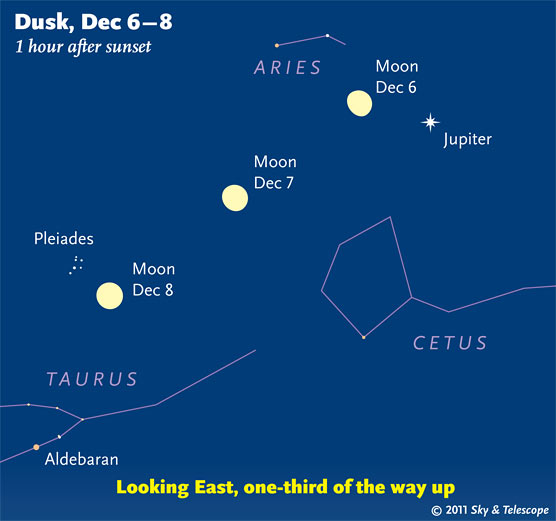
Follow the Moon advancing eastward day by day.
Sky & Telescope diagram
.
Wednesday, Dec. 7
Thursday, Dec. 8
Friday, Dec. 9
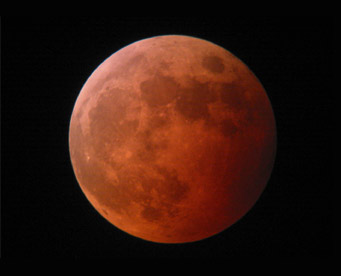
The totally eclipsed Moon of October 27, 2004.
S&T: Richard Tresch Fienberg
The Moon is totally within the umbra of Earth’s shadow for 52 minutes, from 14:05 to 14:57 UT (GMT). The partial stages before and after totality each last more than an hour. See our article A Dawn Eclipse of the Moon, or the fuller article in the December Sky & Telescope, page 58.
Saturday, Dec. 10
Want to become a better amateur astronomer? Learn your way around the constellations. They're the key to locating everything fainter and deeper to hunt with binoculars or a telescope.
For an easy-to-use constellation guide covering the whole evening sky, use the big monthly map in the center of each issue of Sky & Telescope, the essential magazine of astronomy. Or download our free Getting Started in Astronomy booklet (which only has bimonthly maps).

The Pocket Sky Atlas plots 30,796 stars to magnitude 7.6 — which may sound like a lot, but that's less than one star in an entire telescopic field of view, on average. By comparison, Sky Atlas 2000.0 plots 81,312 stars to magnitude 8.5, typically one or two stars per telescopic field. Both atlases include many hundreds of deep-sky targets — galaxies, star clusters, and nebulae — to hunt among the stars.
Sky & Telescope
Once you get a telescope, to put it to good use you must have a detailed, large-scale sky atlas (set of charts). The standards are the little Pocket Sky Atlas, which shows stars to magnitude 7.6; the larger and deeper Sky Atlas 2000.0 (stars to magnitude 8.5); and the even larger Uranometria 2000.0 (stars to magnitude 9.75). And read how to use sky charts effectively.
You'll also want a good deep-sky guidebook, such as Sue French's new Deep-Sky Wonders collection (which includes its own charts), Sky Atlas 2000.0 Companion by Strong and Sinnott, the bigger Night Sky Observer's Guide by Kepple and Sanner, or the classic if dated Burnham's Celestial Handbook.
Can a computerized telescope replace charts? I don't really think so — not for beginners, anyway, and especially not on mounts that are less than top-quality mechanically. As Terence Dickinson and Alan Dyer say in their Backyard Astronomer's Guide, "A full appreciation of the universe cannot come without developing the skills to find things in the sky and understanding how the sky works. This knowledge comes only by spending time under the stars with star maps in hand."
This Week's Planet Roundup
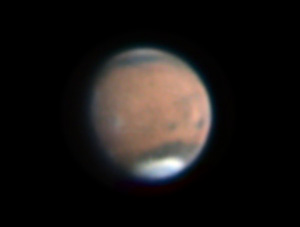
On the morning of December 2nd Mars was 7.1 arcseconds wide and quite gibbous. Although this stacked video image shows far more than you're likely to see in any telescope visually, the North Polar Cap and its dark collar are becoming more apparent. South is up. S&T's Sean Walker took this image with a 12.5-inch Newtonian reflector and a DMK21AU618 video camera.
S&T: Sean Walker
Mercury is hidden in the glare of the Sun.
Venus (magnitude –3.9) shines as the “Evening Star” in the southwest during twilight. It’s getting a little higher every week, on its way to a grand apparition high in the evening sky all this winter and much of the spring (for the Northern Hemisphere).
Mars (magnitude +0.7, in Leo) rises around 11 or midnight, below Regulus and the Sickle of Leo. . It's highest in the south by dawn, with Regulus now to its right. In a telescope Mars is a very small blob only 7 arcseconds wide — about half the diameter it will show at opposition early next March.
Jupiter (magnitude –2.8, at the Aries-Pisces border) blazes high in the southeast at dusk and highest in the south around 9 p.m. In a telescope Jupiter appears 47 arcseconds wide. See our guide to observing Jupiter with a telescope.
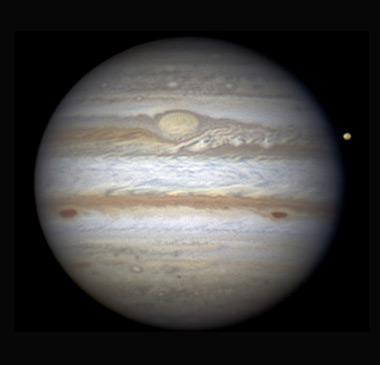
Jupiter's Great Red Spot had just crossed the central meridian when Christopher Go in the Philippines took this world-class image at 12:01UT December 2nd with a 14-inch scope. South is up. "Condition was almost perfect this evening except for some clouds." he writes. "These are some of my best images of Jupiter with the GRS. The dark halo around the GRS is also covering the South Tropical Zone. The North Equatorial Belt is narrowing, making the dark ovals prominent."
Saturn (magnitude +0.8) glows in the southeast before dawn, with Spica (its near twin for brightness at magnitude +1.0) 5&frac;° to its right or lower right. Brighter Arcturus shines far to their left or upper left.
Uranus (magnitude 5.8, near the Circlet of Pisces) and Neptune (magnitude 7.9, at the Aquarius-Capricornus border) are well placed in the southern sky early in the evening. Use our printable finder chart for both, or see the September Sky & Telescope, page 53.
All descriptions that relate to your horizon — including the words up, down, right, and left — are written for the world's mid-northern latitudes. Descriptions that also depend on longitude (mainly Moon positions) are for North America. Eastern Standard Time (EST) equals Universal Time (also known as UT, UTC, or GMT) minus 5 hours.
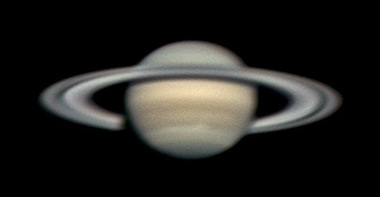
With Saturn emerging into good view before dawn, imagers are starting to go after it. On November 28th, Tomio Akutsu in the low-latitude Philippines took this shot with a 14-inch scope when Saturn was 30° high. South is up. Note the irregular white band at the latitude of the North North Temperate Zone. He writes, "I think Saturn's north phenomenon is stlll going on" — referring to the great white outbreak that began there one year ago.
Tomio Akutsu
Like This Week's Sky at a Glance? Watch our new SkyWeek TV short, now playing on PBS!
NEW BOOK: Sue French's DEEP-SKY WONDERS! This big, long-awaited observing guide by Sky & Telescope's Sue French is available from Shop at Sky. Hefty and lavishly illustrated, it contains Sue’s 100 favorite sky tours (25 per season, with telescopic finder charts) from her 11 years of writing the Celestial Sampler and Deep-Sky Wonders columns for S&T. You know you want it for the holidays….
To be sure to get the current Sky at a Glance, bookmark this URL:
http://SkyandTelescope.com/observing/ataglance?1=1
If pictures fail to load, refresh the page. If they still fail to load, change the 1 at the end of the URL to any other character and try again.
 0
0
Comments
You must be logged in to post a comment.